
Composable Architecture: The Key to Agile & Future-Proof Enterprises
October 04, 2025 / Bryan Reynolds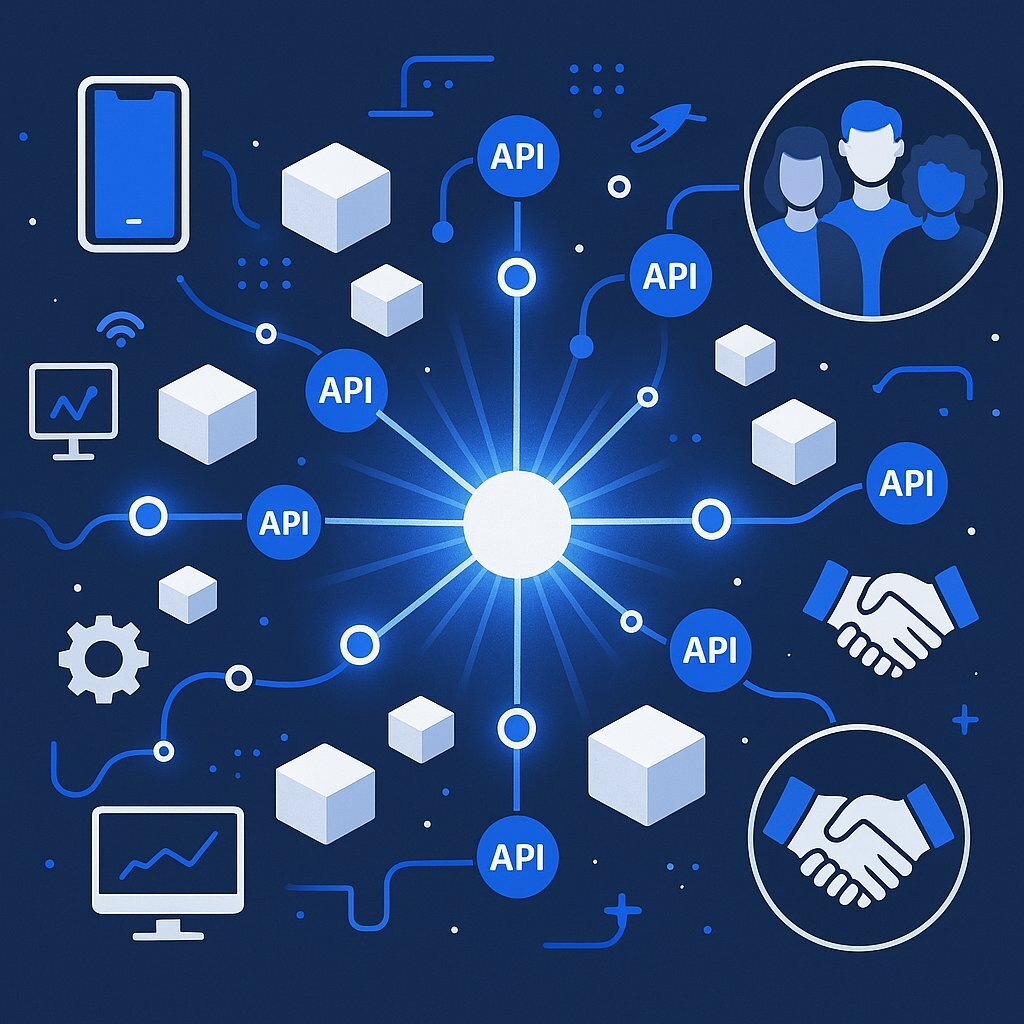
The Future is Composable: Building an Agile Enterprise with a Composable Architecture
The Strategic Imperative: Beyond Technology to Business Transformation
In an era defined by unprecedented volatility, the traditional playbook for enterprise strategy is failing. CIOs and enterprise architects are navigating a landscape marked by geopolitical uncertainty, seismic shifts in customer expectations, and relentless pressure to drive innovation while simultaneously optimizing costs. The established model of planning and executing large-scale, multi-year "big bang" transformations is no longer tenable; by the time such projects are delivered, the market realities they were designed to address have often changed irrevocably. This environment demands a new paradigm—one built not for stability, but for perpetual motion.
This is the strategic imperative for the composable enterprise. It is far more than a new architectural pattern; it is a fundamental business philosophy designed for "real-time adaptability and resilience in the face of uncertainty". The core principle is to architect the entire organization—its technology, processes, and even its culture—from interchangeable building blocks. These components, known as Packaged Business Capabilities (PBCs), can be rapidly assembled, reconfigured, and replaced to meet shifting demands, much like constructing with Lego blocks. This approach moves the enterprise from a state of rigid, periodic change to one of continuous, fluid evolution.
The urgency of this shift is not speculative. Leading industry analysts have identified composability as a critical C-suite agenda item. Gartner forecasted that by 2023, 60% of mainstream organizations would list the composable enterprise as a strategic objective, recognizing its power to accelerate digital transformation. This prediction is underpinned by a stark competitive reality: organizations that successfully adopt a composable approach are projected to "outpace competition by 80% in the speed of new feature implementation". In today's market, this velocity is not just an advantage; it is a prerequisite for survival.
This strategic pivot is a direct response to the inherent limitations of traditional, long-term planning. Business strategy has historically relied on predictable, linear cycles. However, the current environment of extreme market flux renders such rigid plans obsolete almost as soon as they are created. The move to a composable model is a profound acknowledgment that the business itself, not just its IT systems, must be architected for continuous adaptation. The architecture, in effect, becomes the strategy, providing the structural agility to respond to opportunities and threats as they emerge.
Furthermore, the drive toward composability is fueled by a powerful external force: the "experience benchmark" set by digital-native leaders. Customers now measure every digital interaction against the best they have ever had, whether with Amazon, Apple, or Netflix. Legacy monolithic systems, with their protracted and cumbersome development cycles, are structurally incapable of keeping pace with this rapidly escalating standard. A composable architecture, by enabling the rapid and modular deployment of new features and experiences, is the only viable path for established enterprises to compete on customer experience. What began as a competitive necessity in the B2C space is now an urgent requirement for B2B organizations as well, as the expectation for seamless, personalized digital interaction becomes universal.
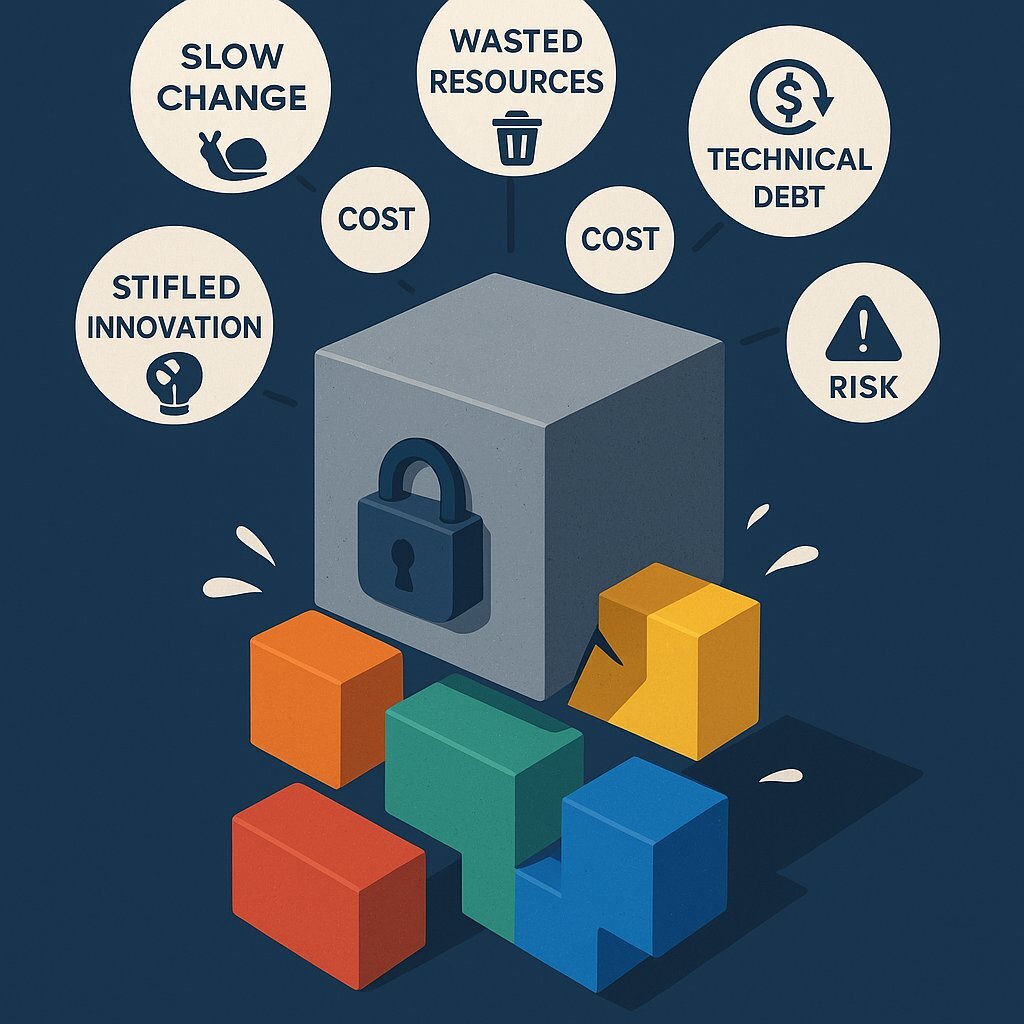
The Monolith in the Room: Quantifying the Hidden Costs of Inflexibility
For many technology leaders, the prospect of a major architectural transformation is daunting, especially when current systems appear to be functioning. The objection is common and understandable: "Our existing applications work, so why introduce the risk and expense of a fundamental change?" To build a compelling business case for composability, it is essential to first deconstruct this assumption and quantify the significant, often hidden, costs of maintaining the monolithic status quo.
It is true that monolithic applications are often simpler to develop and deploy initially. With a single, unified codebase, early-stage development, testing, and debugging can be more straightforward than managing a distributed system. However, this initial simplicity is deceptive. As the application grows in complexity and the business scales, this tightly coupled structure becomes a significant liability, generating compounding technical debt and imposing a tax on every future initiative.
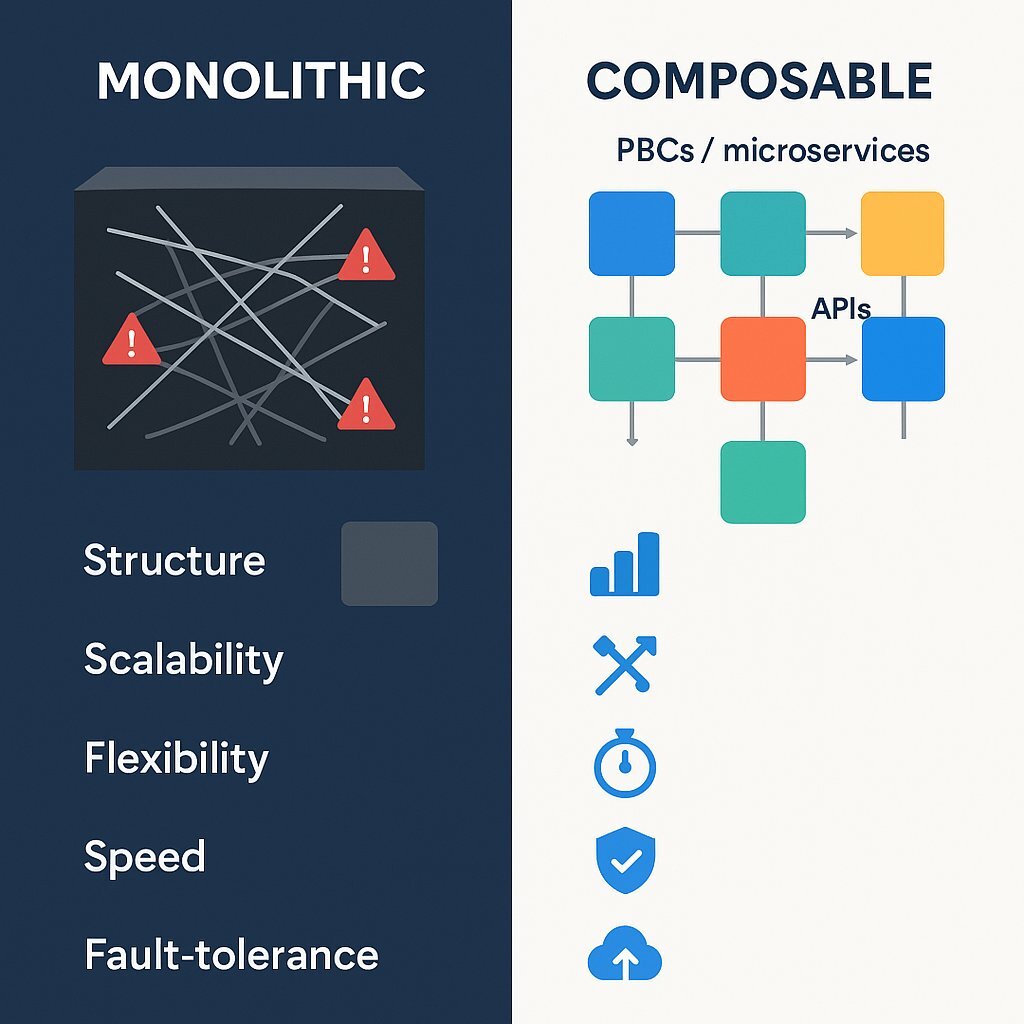
The pain points of a mature monolithic architecture are acute and directly impact the bottom line:
- Crippling Lack of Agility: In a monolithic system, all components are interconnected and interdependent. This means even a minor change to a single function requires the entire application to be rebuilt, re-tested, and redeployed. This process is inherently slow, risky, and expensive, creating long and restrictive update cycles that are fundamentally at odds with the agile methodologies modern development teams need to be effective.
- Inefficient and Costly Scalability: Monoliths suffer from severe scalability bottlenecks. When demand increases for a specific feature—such as a payment processing service during a sales event—the entire application must be scaled. This forces the organization to provision additional resources for every part of the system, even those under normal load, leading to significant resource wastage and inflated infrastructure costs.
- A Barrier to Innovation: The tightly coupled nature of a monolith acts as a powerful deterrent to innovation. Integrating new technologies, programming languages, or frameworks is exceedingly difficult, often requiring a complete and costly re-tooling of the entire application. The enterprise becomes trapped by its initial technology choices, unable to adopt modern tools that could provide a competitive edge. This technological inertia is a significant hidden cost, preventing the business from leveraging advancements in areas like AI and machine learning.
- High-Risk, High-Impact Deployments: Because the entire application is a single, indivisible unit, it represents a single point of failure. A minor bug or error introduced in one module can crash the entire system, leading to a complete service outage that affects all users simultaneously. This high-risk environment discourages frequent updates and fosters a culture of extreme caution, further slowing the pace of innovation.
- Exponentially Growing Technical Debt: As a monolith evolves, its single codebase becomes exponentially more complex. Developers must spend an increasing amount of time navigating intricate dependencies and understanding the potential ripple effects of any change. This complexity becomes a form of technical debt, a drag on productivity that makes maintenance more difficult and new feature development prohibitively slow and expensive.
The contrast with a composable approach is stark. By breaking the system into modular, independent components, a composable architecture directly addresses each of these challenges, transforming liabilities into strategic advantages.
Table 1: Monolithic vs. Composable Architecture at a Glance
This table provides a concise, high-impact summary for a busy executive, crystallizing the fundamental differences and justifying the need for a strategic shift. It serves as a powerful artifact for internal business case presentations.
| Aspect | Monolithic Architecture | Composable Architecture |
|---|---|---|
| Structure | Single, tightly coupled codebase. All components are interdependent. | Modular, loosely coupled components (PBCs, microservices) that function independently. |
| Scalability | Must scale the entire application, leading to resource wastage. | Scale individual components based on demand, optimizing resource use and cost. |
| Flexibility | Rigid. Changes require system-wide updates and risk ripple effects. | Highly flexible. Update, replace, or add components without affecting the whole system. |
| Development Speed | Slow. Long development cycles due to complexity and dependencies. | Fast. Parallel development on independent components accelerates time-to-market. |
| Fault Tolerance | Low. A single point of failure can bring down the entire application. | High. Issues are isolated to individual components, enhancing system resilience. |
| Technology Adoption | Difficult and expensive. Constrained by the initial tech stack. | Easy. Integrate best-in-class technologies and new frameworks on a component-by-component basis. |
The Engine of Agility: Deconstructing the Composable Tech Stack
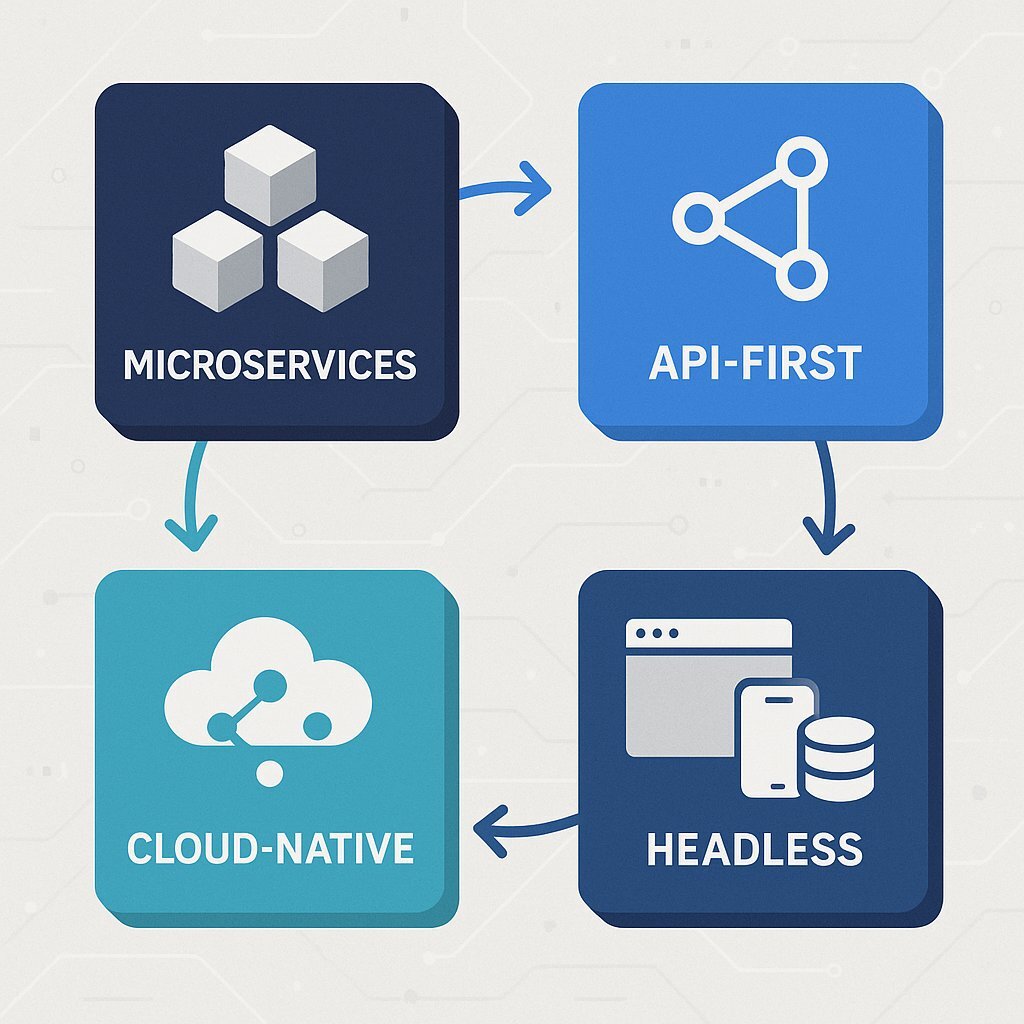
To move from the strategic "why" to the practical "how," it is essential to understand the technological foundations that power a composable enterprise. For a CIO or Enterprise Architect, this is not merely an academic exercise; it is about grasping how each component contributes to the overarching business goals of agility, scalability, and resilience. The industry has coalesced around a set of principles and technologies that form the blueprint for modern, composable solutions, often encapsulated by the acronym MACH.
The MACH Blueprint: A Framework for Modern Architecture
MACH stands for Microservices, API-first, Cloud-native, and Headless. This set of principles provides a clear and robust framework for building enterprise systems that are designed for change.
- Microservices: At the heart of a composable architecture are microservices. These are small, autonomous services, each designed to perform a single, specific business task or capability, such as payment processing, user authentication, or inventory management. Unlike the intertwined components of a monolith, each microservice operates independently, with its own database and business logic. This modularity is often compared to building with Lego blocks; individual pieces can be developed, deployed, and scaled without affecting the others. Real-world pioneers like Netflix and Uber have famously leveraged microservices to achieve massive scale and rapid innovation, demonstrating the power of this approach.
API-First: If microservices are the building blocks, Application Programming Interfaces (APIs) are the standardized contracts that define how they connect and communicate. In an API-first approach, every component is designed from the outset to be accessible via a secure and well-documented API. This turns APIs into the "glue" of the enterprise, creating a universal language that allows disparate services—whether built in-house or sourced from third-party vendors—to work together seamlessly. In a truly composable enterprise, entire business processes are
assembled by orchestrating calls between these APIs, enabling unprecedented flexibility in how business logic is constructed and executed.
- Cloud-Native: The principles of composability are intrinsically linked to the capabilities of the cloud. A cloud-native architecture is designed to leverage the full potential of cloud computing, including elastic scalability, high availability, and on-demand resource provisioning. This is the infrastructure that allows individual microservices to be scaled up or down independently and instantly in response to real-time demand, providing the resilience and cost-efficiency that monolithic systems lack.
- Headless: A headless architecture fundamentally decouples the front-end presentation layer (the "head," such as a website or mobile app) from the back-end business logic and data management systems. The back-end exposes its content and functionality through APIs, allowing any number of different front-ends to consume them. The primary business benefit is the ability to create and deliver consistent, personalized customer experiences across any channel or device—from a web browser to a mobile app, a voice assistant, or an IoT device—all powered by the same set of back-end services.
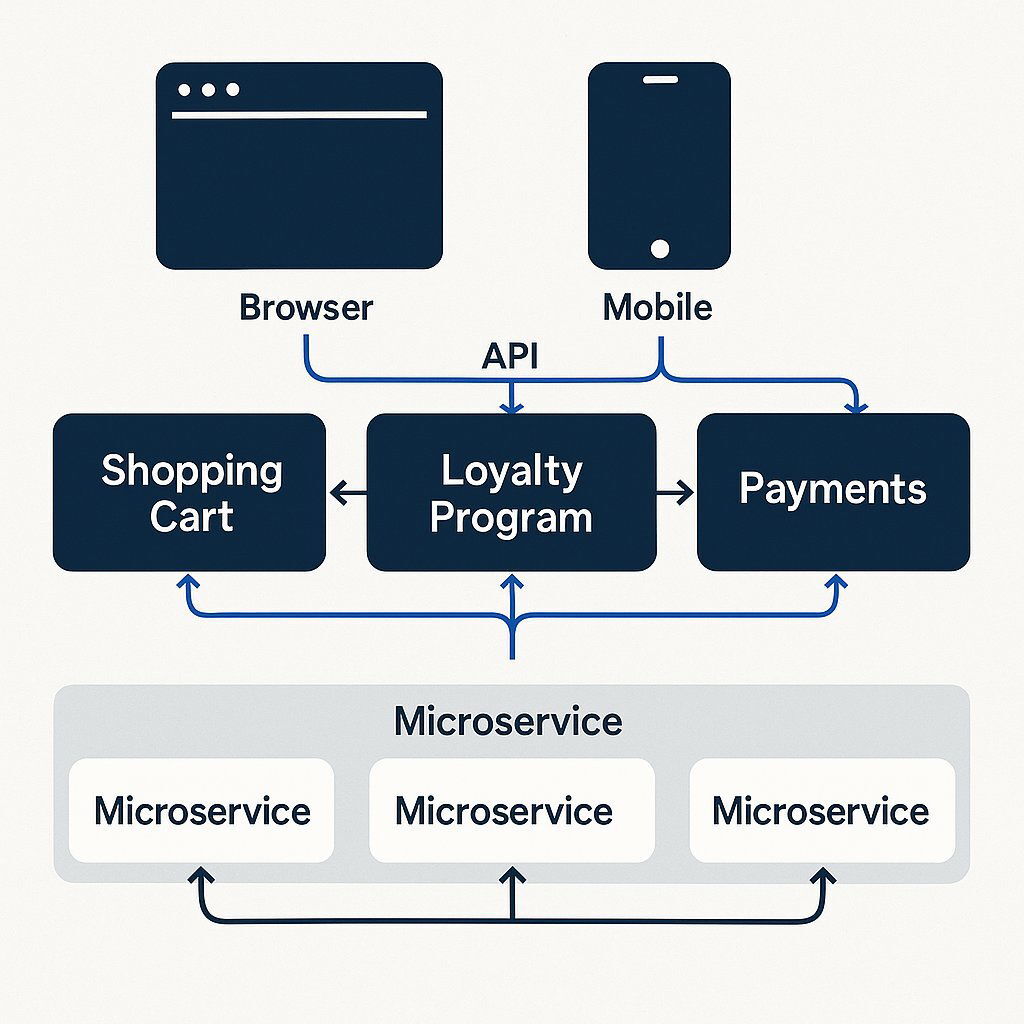
From Microservices to Packaged Business Capabilities (PBCs)
While microservices are a foundational technical concept, the composable enterprise introduces a more business-centric layer of abstraction: the Packaged Business Capability (PBC). A PBC is a software component that represents a complete, well-defined business function that is recognizable to a business user—for example, a "shopping cart," "customer loyalty program," or "identity verification service". A single PBC may be composed of one or several underlying microservices, but it is bundled and exposed as a coherent, reusable business asset. This allows business teams to think in terms of composing business functions rather than orchestrating low-level technical services.
Successfully orchestrating this ecosystem of microservices and PBCs requires deep expertise in modern cloud-native environments. The deployment, scaling, and management of hundreds of independent services is a significant operational challenge. This is where a robust DevOps culture and platform become critical. Leading development partners like Baytech Consulting leverage platforms such as Azure Kubernetes Service (AKS) with Docker containers, managed through Azure DevOps pipelines, to automate the entire lifecycle of these microservices. This approach provides the resilient, scalable, and secure foundation a composable enterprise demands, ensuring that the architectural vision can be realized in production.
This technological shift fundamentally alters the classic "build vs. buy" decision-making process for enterprise software. The traditional model presented a binary choice: build a custom monolithic application from scratch or buy a comprehensive, off-the-shelf suite. Composable architecture introduces a powerful third option: "compose." Organizations can now strategically buy best-in-class, API-driven PBCs for common functions (e.g., a payment gateway from Stripe, a search service from Algolia) and focus their internal development resources on building only those components that create unique competitive differentiation. This hybrid model allows the CIO to optimize investment, leveraging market-leading solutions for commodity capabilities while concentrating precious engineering talent on what truly matters to the business. The CIO's role evolves from that of a simple builder or buyer to that of a strategic integrator and orchestrator of a dynamic digital ecosystem.
This evolution is possible only because of the maturation of the broader API economy. The composable enterprise does not exist in a vacuum; it is a model designed to participate in and leverage a vast external ecosystem of digital services. The widespread availability of mature, reliable, and secure third-party APIs for nearly every conceivable business function is the catalyst that makes this architectural style feasible at scale. An organization's ability to expose its own core competencies as API-driven services can even create new revenue streams, as famously demonstrated by Amazon's transformation of its internal hosting infrastructure into the multi-billion dollar business of Amazon Web Services.
The Business Case: Translating Architecture into Measurable ROI
While the technical elegance and strategic promise of composable architecture are compelling, any proposal for such a significant transformation must be grounded in a robust business case. For the CIO, this means translating architectural benefits into the language of the C-suite and the board: measurable improvements in speed, revenue, cost-efficiency, and risk mitigation. Fortunately, as the adoption of composable principles accelerates, a wealth of data and real-world evidence has emerged to substantiate its value proposition.
The business benefits of a composable enterprise can be grouped into four key areas:
Speed, Agility, and Accelerated Time-to-Market
In a digital economy, speed is a primary competitive differentiator. Composable architecture directly enables a dramatic increase in the velocity of innovation. By breaking down applications into independent, modular components, development teams can work in parallel, building, testing, and deploying new features without the complex dependencies and coordination overhead of a monolithic system. This translates into a significantly faster time-to-market for new products and customer experiences. Industry data shows that 28% of retail executives cite increased speed to market as a key benefit of their composable solutions. The impact can be transformative, with case studies showing companies like Elastic accelerating their development process by 500% and Icelandair reducing the time required to launch new promotions by a staggering 90%.
Revenue Growth and Superior Customer Experience
Agility is not just an internal metric; it directly impacts the customer experience and, consequently, the top line. A composable architecture gives businesses the freedom to create highly differentiated and personalized digital experiences, a capability cited by 30% of retail executives as a primary benefit. By leveraging headless architecture, companies can deliver seamless and consistent experiences across all customer touchpoints, from web and mobile to in-store kiosks and emerging IoT devices. This improved experience drives engagement and conversion. The data is clear: 98% of retailers with a headless architecture report satisfaction with their storefronts, compared to 89% overall. This satisfaction translates into tangible financial results, with improved site performance and tailored experiences directly leading to higher conversion rates.
Operational Efficiency and Cost Reduction
While a composable transformation requires an upfront investment, it is designed to deliver significant long-term savings and operational efficiencies. By allowing individual components to be scaled based on real-time demand, it eliminates the wasteful over-provisioning of resources common in monolithic systems, leading to optimized cloud infrastructure costs. Maintenance is also more efficient; updates and bug fixes can be applied to individual components without disrupting the entire system, reducing downtime and lowering support overhead. Consequently, 27% of retail leaders report a reduction in the total cost of ownership (TCO) after adopting a composable approach.
Future-Proofing, Resilience, and Risk Mitigation
A composable architecture is inherently more resilient. Because components are loosely coupled and operate independently, a failure in one service is isolated and does not cascade to bring down the entire application. This fault isolation dramatically improves system uptime and reliability. Furthermore, the modular nature of the architecture provides a powerful defense against technological obsolescence and vendor lock-in. New technologies, such as AI and machine learning services, can be easily integrated on a component-by-component basis without requiring a full-system overhaul. If a particular vendor's solution no longer meets the business's needs, it can be swapped out for a better alternative with minimal disruption. This ability to continuously evolve the technology stack ensures that the enterprise remains agile and future-proof.
The financial impact of these benefits is not merely theoretical. A commissioned Total Economic Impact™ (TEI) study conducted by Forrester Consulting provides a credible, third-party financial model that quantifies the value of adopting a composable solution.
Table 2: The Total Economic Impact™ of a Composable Transformation
This table translates architectural benefits into the language of the CFO and CEO—ROI, NPV, and payback period. It provides a concrete, defensible financial model for the CIO to use in budget discussions, based on a composite organization analyzed over a three-year period.
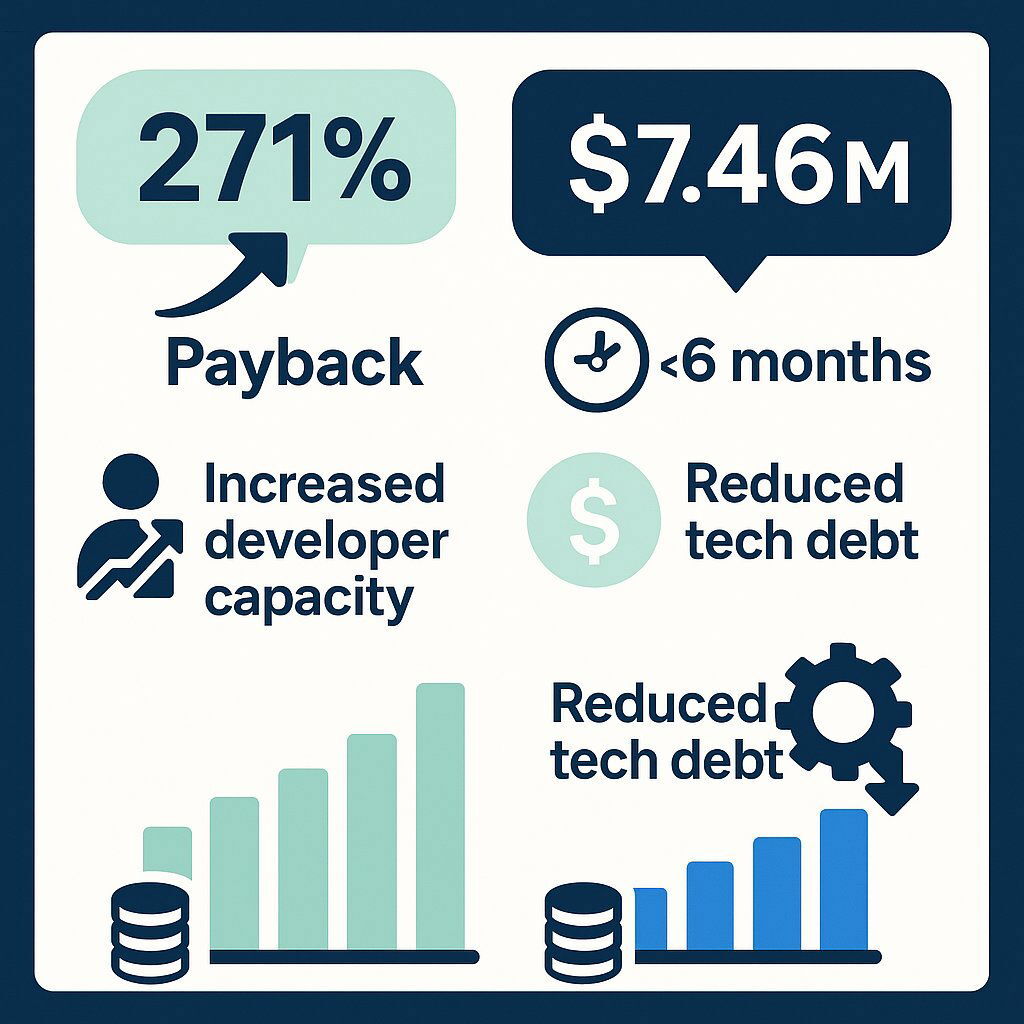
| Financial Metric | 3-Year Risk-Adjusted Value | Key Driver |
|---|---|---|
| Return on Investment (ROI) | 271% | Benefits significantly outweigh costs. |
| Net Present Value (NPV) | $7.46 million | The total value of the investment over three years. |
| Payback Period | < 6 months | Rapid time-to-value for the initial investment. |
| Increased Developer Capacity | $2.85 million | Headless front-end and modular components double developer productivity. |
| Profit from Increased Conversion | $7.09 million | Improved site performance and CX drive a 0.5% conversion rate lift (from 2.5% to 3.0%). |
| Reduced Technical Debt | $264,000 | Decommissioning legacy systems and reducing third-party contract reliance. |
These figures, combined with the growing body of evidence from market adoption—with 83% of organizations implementing a MACH approach seeing a positive ROI and 79% planning to increase their investment—build an undeniable business case. The transition to a composable enterprise is not a cost center; it is a strategic investment in the agility, resilience, and competitiveness of the modern digital business.
The Human Element: Leading the Organizational Shift to Composability
A successful transition to a composable enterprise is as much about people and process as it is about technology. Attempting to implement a modular, agile technology stack within a rigid, siloed organizational structure is a recipe for failure. The architecture of the business must mirror the architecture of its systems. For the CIO, this means stepping beyond the role of a technologist to become a champion of profound cultural and organizational change.
The first and most critical realization is that composability is not a product that can be purchased; it is a "mindset" and a "cultural shift" that must be cultivated. It requires a fundamental change in how the organization perceives the role of IT within the business—moving from a centralized, order-taking service provider to an integrated, value-creating partner.
This transformation rests on several key organizational pillars:
- Breaking Down Silos: The foundational organizational change is the dismantling of the traditional walls that separate business and IT departments. A composable enterprise requires deep, continuous collaboration and cross-functional alignment to ensure that technology solutions are directly and dynamically tied to business outcomes. The goal is to create a unified team with shared objectives, rather than a series of transactional handoffs between disconnected groups.
- Empowering Autonomous "Fusion Teams": The structural manifestation of this new collaborative model is the "Fusion Team." These are multidisciplinary, autonomous groups that bring together individuals with both business and IT skills. Each team is given ownership of a specific business capability from end to end—from ideation and development to deployment and ongoing maintenance. This autonomy empowers them to make decisions faster, experiment with new ideas, and fosters a powerful sense of commitment and accountability for the business value they deliver.
- The Evolving Role of the CIO: In this new model, the CIO's role undergoes a significant evolution. They must transition from being the gatekeeper of technology resources to becoming the organization's "chief innovation officer". Their primary function is no longer to fulfill a backlog of requests, but to provide the strategic vision, the technology platform, and the governance framework that enables business-led innovation to flourish. The CIO becomes an enabler, fostering a culture of experimentation and a "fail fast" mindset where teams are encouraged to test new ideas quickly and learn from the results.
- Cultivating New Talent and Skills: This new way of working demands a new set of skills. Organizations must be prepared to either hire new talent with expertise in cloud-native technologies, API design, and agile methodologies, or invest significantly in upskilling their existing workforce. The emphasis shifts away from deep specialists in a single technology toward "versatilists"—adaptable professionals who possess a breadth of skills and a capacity for continuous learning.
The necessity of these organizational changes is explained by a long-standing principle in software engineering known as Conway's Law, which posits that organizations inevitably design systems that mirror their own communication structures. A monolithic organization, characterized by rigid hierarchies and siloed departments, will naturally produce a monolithic architecture. To successfully build and sustain a modular, loosely coupled, and composable technology ecosystem, the organization itself must first be redesigned to be modular, with communication flowing seamlessly within and between autonomous, cross-functional teams. The organizational redesign is therefore a prerequisite for the technological transformation, not merely a byproduct of it.
This leads to a central challenge for the CIO: establishing a system of governance that balances autonomy with coherence. A composable model democratizes technology delivery, empowering distributed teams to build and deploy services independently. However, without a strong central framework, this freedom can quickly devolve into operational chaos, creating a fragmented landscape of inconsistent standards, security vulnerabilities, and integration nightmares. The most successful composable enterprises resolve this paradox by implementing a system of centralized governance for critical, cross-cutting concerns. This includes establishing and enforcing enterprise-wide standards for API design, security protocols, data models, and observability. The CIO's crucial role is to provide "freedom within a framework"—to empower teams with the autonomy to innovate rapidly while ensuring that their creations can operate together as a secure, reliable, and coherent whole.
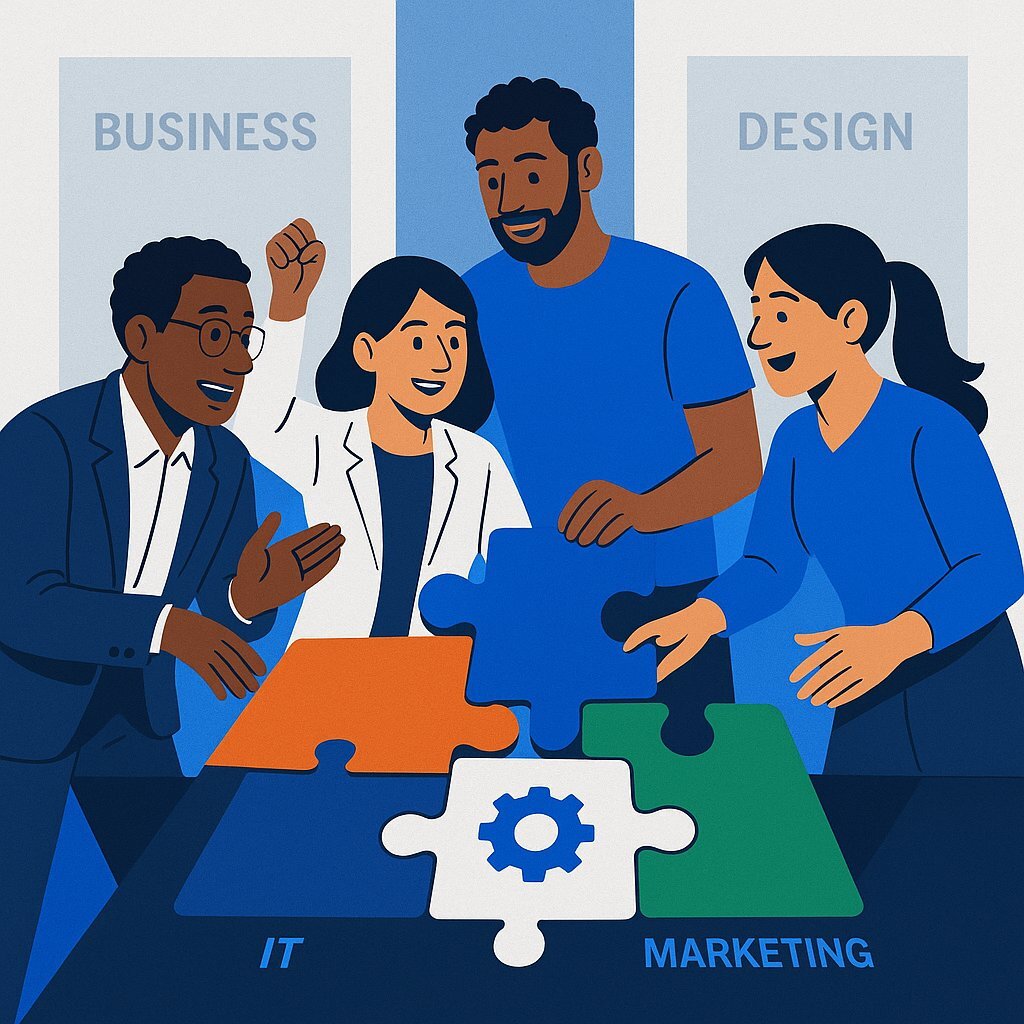
Your Roadmap to a Composable Future: A Pragmatic Guide for CIOs
Embarking on the journey to a composable enterprise is a significant undertaking. While the strategic benefits are clear, the path is not without its challenges. A successful transformation requires careful planning, a pragmatic approach, and a clear-eyed understanding of the potential hurdles, which can include the complexity of managing a distributed system, the need for significant upfront investment, and the difficulties of data management and organizational change management. For the CIO ready to lead this change, the following roadmap provides a structured, step-by-step guide to navigate the transition effectively.
Step 1: Assess and Strategize—Start with the Business, Not the Technology
The most common mistake in any major architectural initiative is to lead with a technology-first mindset. A composable transformation must begin with a deep understanding of the business.
- Map Business Capabilities: The first step is to develop a comprehensive Business Capability Map. This exercise involves breaking down what the organization does into its core functions, independent of how those functions are currently performed. This map allows you to identify which capabilities are most critical to competitive differentiation and which are subject to the most frequent change. These high-change, high-value areas are the prime candidates for modularization.
- Analyze the Current State: Conduct a thorough assessment of your existing technology architecture. Identify the most significant bottlenecks, the systems that are most difficult and costly to update, and the areas where inflexibility is hindering business agility. This analysis will provide a clear picture of the pain points that a composable approach can solve, helping to build the initial business case.
Step 2: Start Small and Prove Value—Adopt an Iterative Approach
A "big bang" replacement of a core monolithic system is a high-risk strategy that is prone to failure. A gradual, iterative approach is far more sustainable and effective.
- Select a Pilot Project: Choose a single, well-defined business area—ideally one identified as high-value in your capability mapping—for a pilot project. The goal is to deliver a tangible business outcome quickly, demonstrating the value of the composable approach and building momentum and support within the organization.
- Implement the "Strangler Pattern": This is a proven and powerful strategy for migrating away from a legacy monolith without a high-risk cutover. The approach involves gradually building new, modular services around the edges of the old system. As new features are required, they are built as independent microservices. Over time, these new services intercept more and more of the traffic and functionality, progressively "strangling" the monolith until it becomes small enough to be safely decommissioned.
Step 3: Establish Strong Governance—Define the Rules of the Road
Before scaling your composable efforts beyond the initial pilot, it is critical to establish a robust governance framework. This is the foundation that prevents distributed development from descending into chaos.
- Develop an API Strategy: Define and enforce clear, consistent standards for API design, documentation, security, and versioning. An API gateway should be implemented to manage traffic, authentication, and monitoring across all services.
- Set Enterprise-Wide Standards: Establish clear guidelines for security protocols, data models, logging, and testing. These standards should be defined centrally and applied consistently across all teams to ensure interoperability and maintainability. Governance is the discipline that ensures flexibility creates business value instead of fragmentation.
Step 4: Partner for Expertise and Acceleration
Most organizations do not possess all the necessary skills and experience in-house to navigate a composable transformation alone. The learning curve for designing, building, and operating a large-scale distributed system is steep. Strategic outsourcing and partnership can be far more efficient and effective than attempting to build these capabilities from scratch.
Embarking on this journey often requires a partner who understands both the strategic vision and the technical execution. The ideal partner doesn't just write code; they act as a strategic guide. Firms like Baytech Consulting specialize in this dual role. They co-create a strategic roadmap by helping you assess your current architecture, identify high-value pilot projects, and then apply their deep expertise in custom software development—using tech stacks like.NET, Node.js, and cloud-native tools—to build the foundational PBCs and microservices that deliver immediate and measurable business value. This partnership model allows the enterprise to accelerate its transformation, mitigate risk, and build internal capabilities through collaboration.
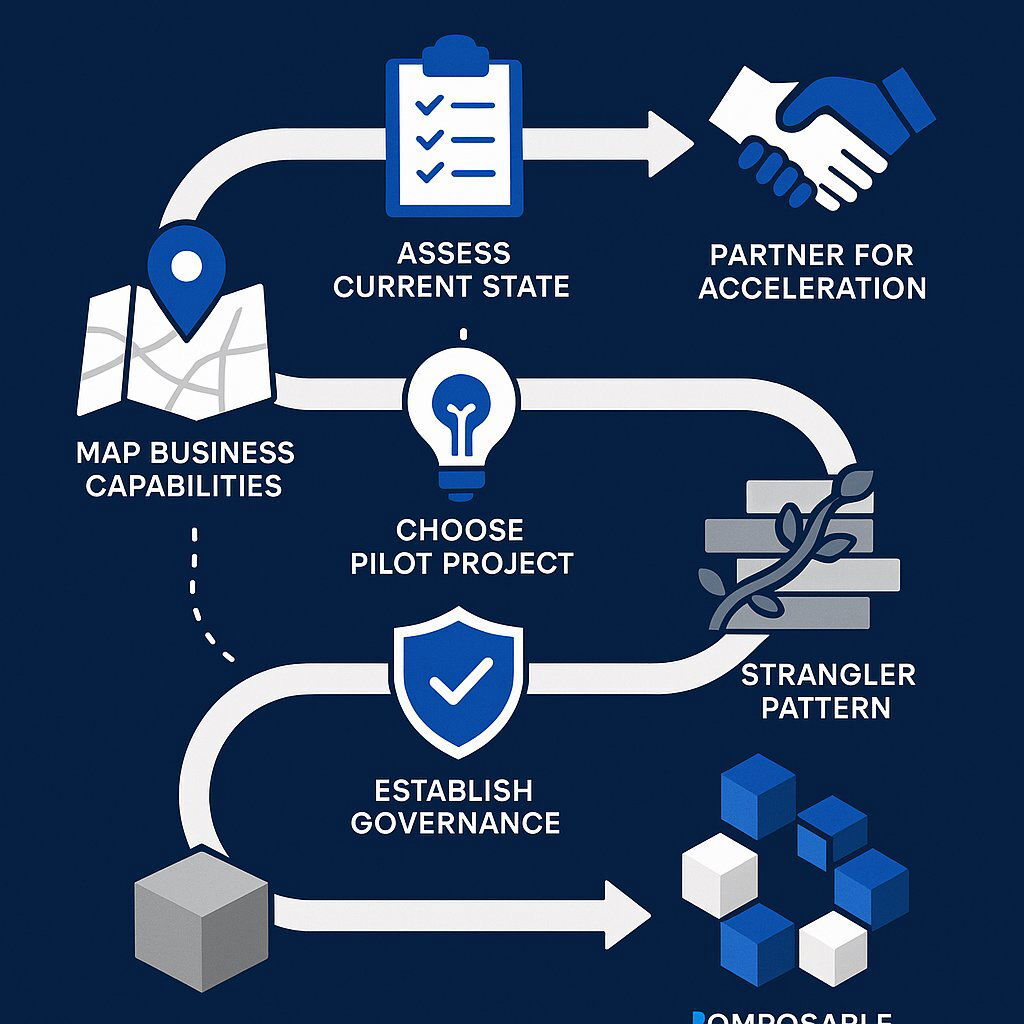
Conclusion: Composing Your Future-Proof Enterprise
In an economic and technological landscape defined by constant, accelerating change, the ability to adapt is no longer a competitive advantage—it is the primary condition for survival. The rigid, slow-moving monolithic enterprises of the past are ill-equipped for this new reality. The future belongs to the composable enterprise: an organization architected from its very foundation for agility, resilience, and continuous innovation.
This transformation is not merely a technological upgrade. It is a strategic reimagining of how a business operates, moving from a static structure to a dynamic ecosystem of interchangeable capabilities. By embracing the core principles of modularity, autonomy, and orchestration, organizations can build the flexibility to outpace competitors, the resilience to withstand market shocks, and the innovative capacity to meet and exceed ever-rising customer expectations. The business case is clear and compelling, supported by quantifiable improvements in speed-to-market, revenue growth, and operational efficiency, and validated by a proven return on investment.
The journey requires more than just a new technology stack; it demands a new mindset, a new organizational structure, and a new kind of leadership from the CIO. It is a challenging path, but a necessary one. The first step is not to launch a massive, multi-year project, but to begin a strategic conversation. It is time to champion this new way of thinking, to assess your organization's core capabilities, and to engage business leaders in a dialogue about where modularity and agility can unlock the most profound and immediate value. The time to start composing your future-proof enterprise is now.
Further Reading
- MACH Architecture: The Future of Digital Solutions An in-depth exploration of the core principles (Microservices, API-first, Cloud-native, Headless) that form the technical foundation of modern composable systems.
- The State of Enterprise Architecture 2025 Report A forward-looking analysis of the key trends shaping the future of enterprise architecture, connecting the rise of composability to broader strategic shifts in the industry.
- Composable Commerce: A Buyer's Guide A practical whitepaper offering guidance and best practices for organizations considering the adoption of composable principles within the critical domain of digital commerce.
About Baytech
At Baytech Consulting, we specialize in guiding businesses through this process, helping you build scalable, efficient, and high-performing software that evolves with your needs. Our MVP first approach helps our clients minimize upfront costs and maximize ROI. Ready to take the next step in your software development journey? Contact us today to learn how we can help you achieve your goals with a phased development approach.
About the Author

Bryan Reynolds is an accomplished technology executive with more than 25 years of experience leading innovation in the software industry. As the CEO and founder of Baytech Consulting, he has built a reputation for delivering custom software solutions that help businesses streamline operations, enhance customer experiences, and drive growth.
Bryan’s expertise spans custom software development, cloud infrastructure, artificial intelligence, and strategic business consulting, making him a trusted advisor and thought leader across a wide range of industries.


